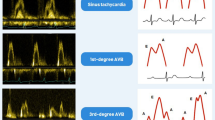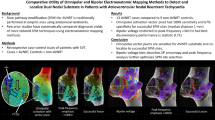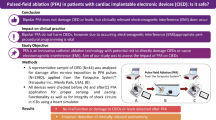Abstract
In previous studies, we established methodology for reconstructing endocardial potentials, electrograms and isochrones from a non-contact intracavitary probe during a single beat. The probe was too large to be introduced percutaneously. Here we examine the possibility of similar mapping with a small multielectrode catheter that could be introduced percutaneously and does not expand inside the cavity. Cavity geometry and endocardial potentials were recorded in an isolated canine left ventricle. Simulated catheter probes were introduced into the cavity. Probe potentials were computed from the measured endocardial potentials and perturbed to include measurement noise, geometrical errors, and limited electrode density. Endocardial potentials were then reconstructed from the perturbed probe potentials and compared to the actual measured potentials. Of all probes simulated, a 3.0 mm (9F) catheter that assumes a curved geometry (e.g., a J shape) inside the cavity performed best (better than a larger 7.6 mm cylinder simulating an inflatable probe). Without bending, a straight cylindrical probe of the same size (9F, 3.0 mm) did not perform well. Sixty probe electrodes were needed for accurate reconstruction. The J-probe reconstruction was very robust in the presence of noise (10%) and of geometry errors (3 mm shift, 10° rotation). The results demonstrate the feasibility of accurate single-beat endocardial mapping using a 9F percutaneous multielectrode catheter that assumes a J shape in the cavity without the need for expansion (e.g., into a balloon or a “basket”). The robustness of the procedure to noise and geometrical errors suggests its applicability in the clinical EP laboratory and the possibility of determining probe position in vivo using current imaging modalities. © 1998 Biomedical Engineering Society.
PAC98: 8759Wc
Similar content being viewed by others
REFERENCES
Brebbia, C. A., and J. Dominguez. Boundary Elements: An Introductory Course. New York: McGraw-Hill, 1989.
Burnes, J. E., D. C. Kaebler, B. Taccardi, R. L. Lux, P. R. Ershler, and Y. Rudy. A field-compatible method for interpolating biopotentials. Ann. Biomed. Eng.26:37-47, 1998.
Chu, E., A. P. Fitzpatrick, M. C. Chin, K. Sudhir, P. G. Yock, and M. D. Lesh. Radiofrequency catheter ablation guided by intracardiac echocardiography. Circulation89(3):1301-1305, 1994.
Colli-Franzone, P., L. Guerri, B. Taccardi, and C. Viganotti. Finite element approximation of regularized solutions of the inverse potential problem of electrocardiography and applications to experimental data. Calcolo22:91-186, 1985.
De Bakker, J. M. T., M. J. Janse, F. J. L. Van Cappelle, and D. Durrer. Endocardial mapping by simultaneous recording of endocardial electrograms during cardiac surgery for ventricular aneurysm. J. Am. Coll. Cardiol.2:947-953, 1983.
de Buijin, N. P., and F. M. Clements. Transesophageal Echocardiography. Boston, MA: Martinus Nijhoff, 1987.
Derfus, D. L., and T. C. Pilkington. Assessing the effect of uncertainty in intracavity electrode position on endocardial potential estimates. IEEE Trans. Biomed. Eng.39(7):676- 681, 1992.
Derfus, D. L., T. C. Pilkington, E. W. Simpson, and R. E. Ideker. A comparison of measured and calculated intracavity potentials for electrical stimuli in the exposed dog heart. IEEE Trans. Biomed. Eng.39(11):1192-1206, 1992.
Eldar, M., D. G. Ohad, J. J. Goldberger, Z. Rotstein, S. Hsu, D. K. Swanson, and A. J. Greenspon. Transcutaneous multielectrode basket catheter for endocardial mapping and ablation of ventricular tachycardia in the pig. Circulation96:2430-2437, 1997.
Gepstein, L., G. Hayam, and S. A. Ben-Haim. A novel method for nonfluoroscopic catheter-based electroanatomical mapping of the heart. Circulation95:1611-1622, 1997.
Greenspon, A. J., S. S. Hsu, and S. Datorre. Successful radiofrequency catheter ablation of sustained ventricular tachycardia postmyocardial infarction in man guided by a multielectrode “basket” catheter. J. Cardiovasc. Electrophysiol.8:565-570, 1997.
Harada, A., H. J. D'Agostino, R. B. Schuessler, J. P. Bioneau, and J. L. Cox. Potential distribution mapping: new method for precise localization of intramural septal origin of ventricular tachycardia. Circulation78(III):137-147, 1988.
Jenkins, K. J., E. P. Walsh, S. D. Colan, D. M. Bergau, J. P. Saul, and J. E. Lock. Multipolar endocardial mapping of the right atrium during cardiac catheterization: description of a new technique. J. Am. Coll. Cardiol.22(4):1105-1110, 1993.
Josephson, M. E., L. N. Horowitz, S. R. Spielman, H. L. Waxman, and A. M. Greenspan. Role of catheter mapping in the preoperative evaluation of ventricular tachycardia. Am. J. Cardiol.49:207-220, 1982.
Khoury, D. S., B. Taccardi, R. L. Lux, P. R. Ershler, and Y. Rudy. Reconstruction of endocardial potentials and activation sequences from intracavity probe measurements. Circulation91:845-863, 1995.
Khoury, D. S., and Y. Rudy. A model study of volume conductor effects on endocardial and intracavitary potentials. Circ. Res.71:511-525, 1992.
Khoury, D. S., and Y. Rudy. Reconstruction of endocardial potentials from intracavitary probe potentials: a model study. In: Proceedings of Computers in Cardiology, Durham, NC. New York: IEEE, 1992, pp. 9-12.
King, D. L., A. L. Gopal, P. M. Sapin, K. M. Schroder, and A. N. Demaria. Three dimensional echocardiography. Am. J. Card. Imaging7:209-220, 1993.
Intracardiac and Thoracic Mapping of Late Ventricular Potentials, edited by D. Lacroix, P. Savard, M. Shemasa, M. Kaltenbrunner, R. Cardinal, P. Page, and R. Nadeau. Mount Kisco, NY: Futura Publishing, 1993.
Liu, Z. W., P. Jia, P. R. Ershler, B. Taccardi, R. L. Lux, D. S. Khoury, and Y. Rudy. Noncontact endocardial mapping: Reconstruction of electrograms and isochrones from intracavity probe potentials. J. Cardiovasc. Electrophysiol.8:415- 431, 1997.
Messinger-Rapport, B. J., and Y. Rudy. Noninvasive recovery of epicardial potentials in a realistic heart-torso geometry. Circ. Res.66:1023-1039, 1990.
Moorman, J. W., R. E. Melen, B. Skillicorn, and E. G. Solomon. Three-dimensional endocardial mapping system using a novel X-ray imager and locating catheter. J. Electrocardiol. Suppl.27:139-145, 1994.
Oster, H. S., B. Taccardi, R. L. Lux, P. R. Ershler, and Y. Rudy. Electrocardiographic imaging: Noninvasive characterization of intramural myocardial activation from inversereconstructed epicaridal potentials and electrograms. Circulation97:1496-1507, 1998.
Oster, H. S., B. Taccardi, R. L. Lux, P. R. Ershler, and Y. Rudy. Noninvasive electrocardiographic imaging: Reconstruction of epicardial potentials, electrograms, and isochrones and localization of single and multiple electrocardiac events. Circulation96:1012-1024, 1997.
Peters, N. S., W. M. Jackman, R. J. Schilling, G. Beatty, and D. W. Davies. Human left ventricular endocardial activation mapping using a novel noncontact catheter. Circulation95:1658-1660, 1997.
Pilkinton, T. C., W. Krassowska, M. N. Morrow, and R. E. Ideker. Feasibility of estimating endocardial potentials from cavity potentials. In: Ninth Conference of the Engineering in Medicine and Biology Society. New York: IEEE, 1987.
Ramaswami, G., A. Al-kutoubi, A. N. Nicolaides, G. Geroulakos, M. Ferrara-Ryan, F. Aref, N. Labropoulos, and G. Sutton. Duplex controlled angioplasty. Eur. J. Vasc.8:457- 463, 1994.
Rudy, Y., and B. J. Messinger-Rapport. The inverse problem in electrocardiography: solution in terms of epicardial potentials. CRC Crit. Rev. Biomed. Eng.16:215-268, 1988.
Rudy, Y., and H. S. Oster. The electrocardiographic inverse problem. CRC Crit. Rev. Biomed. Eng.20:25-46, 1992.
Spielman, S. R., E. L. Michelson, L. N. Horowitz, J. F. Spear, and E. N. Moore. The limitation of epicardial mapping as a guide to the surgical therapy of ventricular tachycardia. Circulation57:666-670, 1978.
Taccardi, B., G. Arisi, E. Macchi, S. Baruffi, and S. Spaggiari. A new intracavity probe for detecting the site of origin of ectopic ventricular beats during one cardiac cycle. Circulation75:272-281, 1987.
Tikhonov, A. N., and V. Y. Arsenin. Solution of Ill-Posed Problems. Washington, DC: VH Winston & Sons, 1977.
Author information
Authors and Affiliations
Rights and permissions
About this article
Cite this article
Liu, Z.W., Jia, P., Biblo, L.A. et al. Endocardial Potential Mapping from a Noncontact Nonexpandable Catheter: A Feasibility Study. Annals of Biomedical Engineering 26, 994–1009 (1998). https://doi.org/10.1114/1.32
Issue Date:
DOI: https://doi.org/10.1114/1.32




